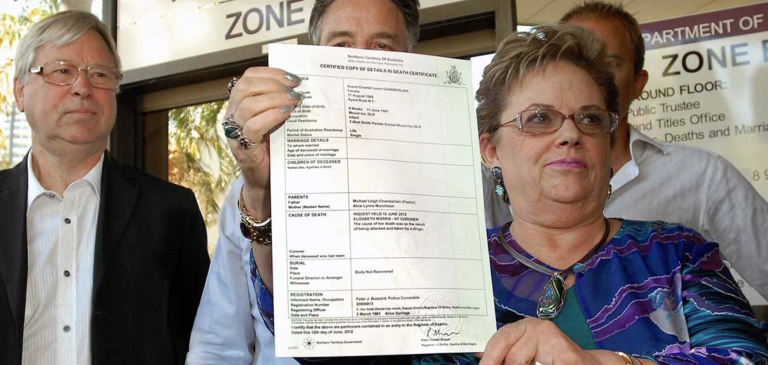Evidence Excluding Smothering
Table of Contents
The most import requirement that is stressed in all criminal trials is that the onus of establishing guilt is to the standard of beyond reasonable doubt. This standard of proof stays immovably with the prosecution throughout a trial. In Kathleen Folbigg’s case an essential element that needed to be proved beyond reasonable doubt was that she intended to kill or cause grievous bodily harm to her children Caleb, Patrick, Sarah and Laura. The prosecution said she smothered them. So central to the prosecution case was the requirement that it could show, beyond reasonable doubt, that the cause of their deaths was smothering.
The prosecution did not present evidence of smothering. Moreover, evidence of smothering can be excluded, although this was never a requirement of law placed on the defence at trial. What was essential was that the prosecution exclude a reasonable possibility consistent with innocence, that is it needed to exclude natural cases of death. The prosecution could not exclude natural causes of death at the time of trial. Since the time of trial, reversing the onus of proof, it can now be shown beyond reasonable doubt that the children died of natural causes.
Trial Requiring ‘Consistent With’ – A Misleading Approach
The most the prosecution had to support smothering as a cause of death was revealed in its opening address to the jury when the following words were said:
“It is extremely easy for an adult to deliberately smother a young child, a baby, and to leave no trace of any external injury whatsoever, such as bruising. This is especially so if a pillow or other soft object is used, or even a hand.”[1]
No doubt an adult could easily deliberately smother a young child, at least physically. Leaving no trace is another matter, and in the case of Laura Folbigg, because she was older it could reasonably be assumed there might be some signs. However, it is for the prosecution to advance its case and it decided a pillow, other soft object or even a hand might do it and it advanced those propositions without a scintilla of evidence that any of these objects were used.
The prosecution advanced its case without evidence of smothering, so it needed to rely on a negative to prove a positive. It did this through the use of expert witnesses who were asked if the absence of evidence was ‘consistent with’ smothering (consistent with is used approximately 178 times at trial); and by use of the word ‘asphyxia’ or ‘asphyxiation’ as a cause of death. This approach allowed for speculation and suspicion to flourish and by the end of the case, along with some other equally objectional features, to overwhelm the only task the jury had, that being to determine whether the prosecution had proved its case beyond reasonable doubt.
The use of the term ‘consistent with’ smothering by the prosecution to promote the idea that the children were smothered not only invited the jury to speculate, but it also allowed for confusion to flourish, and its use also whittled away a number of fundamental legal principles. The most obvious principles that was under attack was the onus and standard of proof. At the very least the prosecution was required to bring relevant probative evidence of guilt. Asserting that the absence of evidence of smothering was consistent with smothering did not provide relevant, probative evidence of smothering. An example, that hopefully would be inadmissible but that is by analogy explanatory is where in a murder trial the absence of DNA of an accused on a murder weapon is used by the prosecution to promote the idea that it could have been present and thus its absence supported the proposition that it was there at some point of time, but it was just not found.
Some examples of ‘consistent with’ used by the prosecution are:
Professor Peter Berry who was retired from the University of Bristol. He specialised in children’s deaths. He was enlisted by the police officer in charge of the case, Ryan. He gave evidence at the trial in 2003 regarding Sarah in the following way:
- If you had been conducting this case is isolation, this post-mortem in isolation, what would have been your diagnosis?
- A. I probably would have, in isolation, given the cause of death of SIDS, but with the slight misgiving about Sarah’s age.[2]
And:
- And in relation to Sarah was the death also consistent with suffocation?
- Yes, it was.[3]
Professor Berry by use of the words ‘in isolation’ was also being influence by the fact that four children had died in the one family.
Professor Herdson was approached by Detective Ryan in November 2001 when he was the head of pathology for the Australian Capital Territory.
- The findings in relation to the post-mortem of Sarah, are they consistent with suffocation?
- I believe so.
- And what do you say to the proposition that Sarah also died from a sudden acute catastrophic asphyxiating event of unknown causes?
- I think, given the circumstances, that is true.[4]
Professor Roger Byard called by the defence at trial in 2003.
- And I think that in relation to Sarah you found that her death was from undetermined causes?
- That’s correct.
- And – of course that also includes deliberate suffocation?
- That ‘ s correct.[5]
Professor John Hilton worked at the Institute of Forensic Medicine, Glebe. He did the autopsy on Sarah on 31 August 1993.
- Those findings in and around the lungs, are you able to say whether or not they are consistent with the child being asphyxiated to death?
- A. They are consistent with an asphyxial mode of death.
- By “an asphyxial mode of death”, does that include a deliberate smothering of the child?
- Yes.[6]
Professor Hilton was not saying that the cause of death was smothering, just that his findings might be seen in a number of types of deaths. He made it clear that what he found was not a specific sign for smothering.
The prosecutor isolated smothering. Professor Hilton’s answer was not evidence proving smothering and the evidence given by the other experts at trial did not provide positive evidence of smothering. The approach taken by the prosecution by analogy would be where a bruise was found on the leg of a deceased who had accidently fallen down stairs, in such a case if the question was asked; ‘Is such bruising consistent with the deceased having been hit with a blunt object?’ The answer might well be ‘Yes’, but without evidence of a blunt object being used the question and answer would be misleading. Simply adding there could be other causes when suspicion is aroused does not solve the problem of having introduced a concept without evidence to support it.
Asphyxiation – Not a Cause
The use of the word ‘asphyxia’ or ‘asphyxiation’ also introduces misleading evidence. Asphyxia comes from the Greek meaning an absence or stoppage of the pulse. It has come to be used to describe a lack of oxygen either complete (anoxia) or partial (hypoxia). Asphyxiation is not a cause of death. The lack of oxygen called asphyxia can have the following features:[7]
- congestion of the face (red appearance of the skin of the face and head;
- oedema (fluid retention) of the face;
- cyanosis (blueness) of the skin of the face;
- petechial haemorrhages (tiny pinpoint haemorrhages) in the in the skin of the face and eye.
Richard Shepherd makes clear that petechial haemorrhages found on the heart or lungs can be from there because of many conditions and they ‘are not . . . evidence of ‘external respiratory obstruction.’[8] Petechial haemorrhages on the skin of the face and eyes although not findings in the cases of Caleb, Patrick, Sarah or Laura, are also ‘not diagnostic of asphyxia.’[9]
The fact that petechial haemorrhages were not even relevant in Sarah Folbigg’s case is given in the evidence of the forensic pathologist, Cala, who originally thought the cause of death in Laura Folbigg’s case was undetermined. He stated in evidence-in- chief:
Question: What about children who have been smothered?
Answer: They may either have petechial hemorrhages or they may not.
Question: Is this the case, that petechial hemorrhages on the heart, lungs and thymus don’t assist a pathologist to distinguish between SIDS and smothering?
Answer: I don ‘ t believe so.
Question: In your opinion if a child is smothered, would it inevitably leave some trace or sign around the head or mouth or anywhere else?
Answer: No, it may well not. There have been reports of children that had petechial hemorrhages on the eye lids and around the eyes as being suggestive of smothering, but their absence certainly does not exclude that possibility.[10] (T 15/4/2003, 710)
The fact that oxygen ceases its travel around the body is self-evident in every death. The actual externally induced causes of death that can lead to the cessation of oxygen include:
- Suffocation (plastic bag or where gases are present)
- Smothering (blockage of the external orifices – mouth and nose)
- Gagging (air passages obstructed with a cloth or soft object)
- Choking (internal obstruction of the upper air passages, for example by toys or dentures)’
- Manual Strangulation
- Ligature Strangulation
- Hanging
- Sexual Asphyxias’
- Traumatic Asphyxias
- Vagal Inhibition or Reflex Cardiac Arrest
At trial, the prosecutor had no physiological basis for concluding murder by way of smothering or anything else because there was no evidence of unnatural causes of death identified by the post-mortems. He, however, made various attempts to get experts to say oxygen cessation occurred before the heart stopped. It is assumed he embarked on this line of questioning to obtain evidence which he could then use to demonstrate that the children died from a lack of oxygen, which he could then equate with smothering. This approach is best demonstrated in the following evidence given by Dr Owen Jones, a specialist paediatric cardiologist at Sydney Children’s Hospital and before that Guy’s Hospital in London. He said in relation to Laura Folbigg’s death:
Question: Do you agree with his evidence that is it is most likely that breathing stopped before the heart stopped given that tracing?
Answer: I don’t know how that judgment could be made.
Question: So you disagree with that?
Answer: I would have to disagree with it because I can ‘t agree with it, yes.
Question: Is it the case of you disagreeing with it or case of you saying your not able to make a judgment?
Answer: As I said earlier I don’t think I am presented with anything here which allows me to make that distinction about whether breathing stopped before the heart stopped…So I would have to presume that the mechanical aspect of breathing isn’t necessarily the determining factor here.
Question: Would you expect to find agonal rhythm if a person had died of myocarditis?
Answer: It is the final electrical activity that is seen from the wide variety of mechanisms, so I would not be surprised to see it.[11]
The evidence of possibilities should never have been allowed because it was misleading, confusing, unfairly prejudicial and a waste of time.[12] If the evidence had been excluded the prosecution could not have been able to advance smothering as a cause. Nevertheless, having been allowed to advance smothering without evidence there are other bases for excluding it as a cause of death.
Determining Cause of Death
When determining cause of death, it is appropriate to exclude other causes before reaching a conclusion. If cause of death has been satisfactorily identified, then other causes have been excluded; if they have not been excluded then the death should be recorded as undetermined.
The only death that has been recorded as undetermined, subsequently changed by forensic pathologists at the 2019 Inquiry to Myocarditis is in Laura Folbigg’s case. Her cause of death has changed again since the Inquiry to ‘sudden unexpected death caused by calmodulinopathy due to a CALM2 G114R mutation, with the lethal cardiac arrest likely precipitated by her myocarditis or exposure to pseudoephedrine’, this cause has been confirmed by forensic pathologists, scientists and medical practitioners. Having finally come to an acceptable cause of death by those who have the responsibility to determine such matters, smothering has been excluded and goes into the realm where it always belonged, that of suspicion and speculation.
The same applies in Sarah Folbigg’s case where the cause of death has now been determined as ‘sudden unexpected death caused by calmodulinopathy due to a CALM2 G114R mutation, with the lethal cardiac arrest likely precipitated by her concurrent infection.’
Exclusion by Reasoning
Assuming smothering is relevant, that is going to a fact in issue in the Kathleen Folbigg trial, the first thing that should be noted is that all other causes of death that could not be excluded are also equally relevant. A short but by my no means a comprehensive list include:
- Vagal Inhibition or Reflex Cardiac Arrest
- Traumatic Asphyxias
- Myocarditis in the case of Laura
- Epilepsy in the case of Patrick
- Genetic variants in all cases.
The first two were not promoted by the prosecution as causes of death. The reason for leaving them out remains unexplained. It may simply have been that too many possibilities would weaken their case. The second two (3 and 4 above) were raised primarily by the defence but were obviously dismissed by the jury because of the Meadows Law infection.[13] The last cause (5) was raised but obviously dismissed by the jury, but it is now overwhelmingly relevant, probative and confirms causes of death.
The issue though is not simply whether something is relevant, most things in a criminal trial are relevant, including the name of the person being accused. The issue forced on Kathleen Folbigg now is whether smothering as a cause of death can be excluded. In her case the suggestion of smothering simply has no probative value and can and should have been excluded because there is no evidence of smothering and there are natural causes of death, to do otherwise allows unfair prejudice.[14] This is not a case where there is no body and, without a confession, the cause cannot be known or a case where the body is so degraded that the cause of death cannot be identified. In each case there were post-mortems and no evidence of smothering, but now strong evidence of natural causes in the cases of Patrick, Sarah and Laura. Therefore, smothering can be excluded.
The question ‘is it just possible’ often posed by desperate lawyers and what in effect happened in the Folbigg trial has no place. It has no place in a case where it is the duty of the prosecution to prove the guilt of an accused person: described as the ‘one golden thread’ in the ‘web of the English Criminal Law’.[15] The onus (often called the burden) of establishing guilt is to the standard of beyond reasonable doubt and it stays immovably with the prosecution throughout a trial, an accused person does not have to do anything. Where possibilities are floated by the prosecution, they are simply inviting speculation not seeking that a jury apply the highest standard of proof known in the common law world.
Another critical issue in any criminal trial is that throughout a trial an accused is presumed to be innocent. The standard direction given to a jury is, ‘a person charged with a criminal offence is presumed to be innocent unless and until the Crown persuades a jury that the person is guilty beyond reasonable doubt’.[16] The presumption of innocence stays with an accused until such time as a tribunal of fact finds the accused guilty; this is said to have the effect of maintaining the burden of proof with the prosecution throughout the trial. By introducing highly prejudicial, misleading evidence and smothering without evidence the jury was being encouraged to engage in irrational reasoning unsupported by hard scientific and medical facts. Additionally, the onus of proof was being reversed and Kathleen Folbigg was being told that she needed to prove natural causes of death: she has now done it after 18 years in gaol.
As a matter of logic, applying inferential reasoning, the absence of evidence properly allows the inference to be drawn that smothering could be excluded, this is especially the case where such evidence would be expected to be found, as in the case of Laura Folbigg.
There is evidence of natural causes in each case, and this also allows the exclusion of smothering as a cause of death.
In order to complete the reasons for exclusion of smothering it is relevant to mention the words written by Kathleen Folbigg in the dairies and journals. It is, of course, always possible to have a conviction for murder without a cause of death. In such cases a confession is one of the main ways of overcoming the problem for the prosecution. The prosecution in Folbigg’s case did use some words in her writings to suggest she was guilty of murdering her children. The obvious point is that if there was a confession the prosecution would have said she admitted smothering her children, so her words cannot be used to show smothering.
However, to complete the reasons for those who rely on suspicion and speculation, the first point that needs to be made is that her writings do not contain any confessions, and there is no such thing as a ‘virtual admission’ as claimed in the 2019 Inquiry Report. Second, there are now available seven expert reports from psychiatrists and psychologists saying, amongst other things: Kathleen Folbigg does not have a mental heath issue that could be used to support a finding of murder, manslaughter or that she otherwise hurt her children; her writings contain no confessions of criminal acts of any type; and she is suffering because of the loss of her children. Third, it has always been conceded by the judge who admitted the evidence and allowed the trials to be joined and by some who were used as experts by the prosecution to develop its case that if there were natural causes then the diaries should not be considered.[17]
[1] Trial Transcript, 1/4/2003, page 32.
[2] Trial Transcript, 1/5/2003, page 1064.5.
[3] Ibid page 1065.40.
[4] Ibid page 1038.45.
[5] Trial Transcript 7/5/2003, page1241.40.
[6] Trial Transcript 14/4/2003, page 619.15.
[7] Richard Shepherd, Simpson’s Forensic Medicine, 2003, 94.
[8] Ibid 95.
[9] Ibid 94.
[10] Trial Transcript 15/4/2003, page 710.
[11] Trial Transcript 8/5/2003, pages 1277-1278.
[12] Evidence Act 1995 (NSW)
135 General discretion to exclude evidence
The court may refuse to admit evidence if its probative value is substantially outweighed by the danger that the evidence might—
(a) be unfairly prejudicial to a party, or
(b) be misleading or confusing, or
(c) cause or result in undue waste of time.
See also section 136.
[13] One death is sad, the second death is suspicious, the third death is homicide unless otherwise excluded.
[14] Evidence Act 1995 (NSW)
137 Exclusion of prejudicial evidence in criminal proceedings
In a criminal proceeding, the court must refuse to admit evidence adduced by the prosecutor if its probative value is outweighed by the danger of unfair prejudice to the defendant.
[15] Woolmington v DPP [1935] AC 462, 481.
[16] Judicial Commission of New South Wales, Bench Book, 3-600.
[17] See Garbutt, Report, 4 February 200, page 1, ‘My opinion is dependent upon the elimination of natural causes to explain the death of the four Folbigg children. If natural causes are eliminated then in my opinion . . . .’





